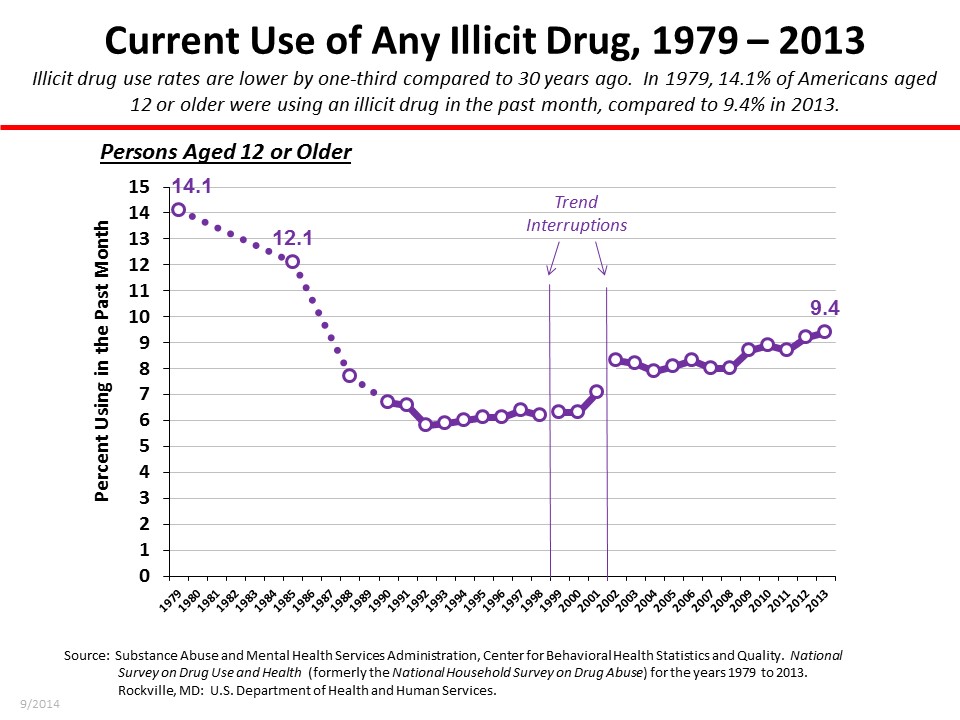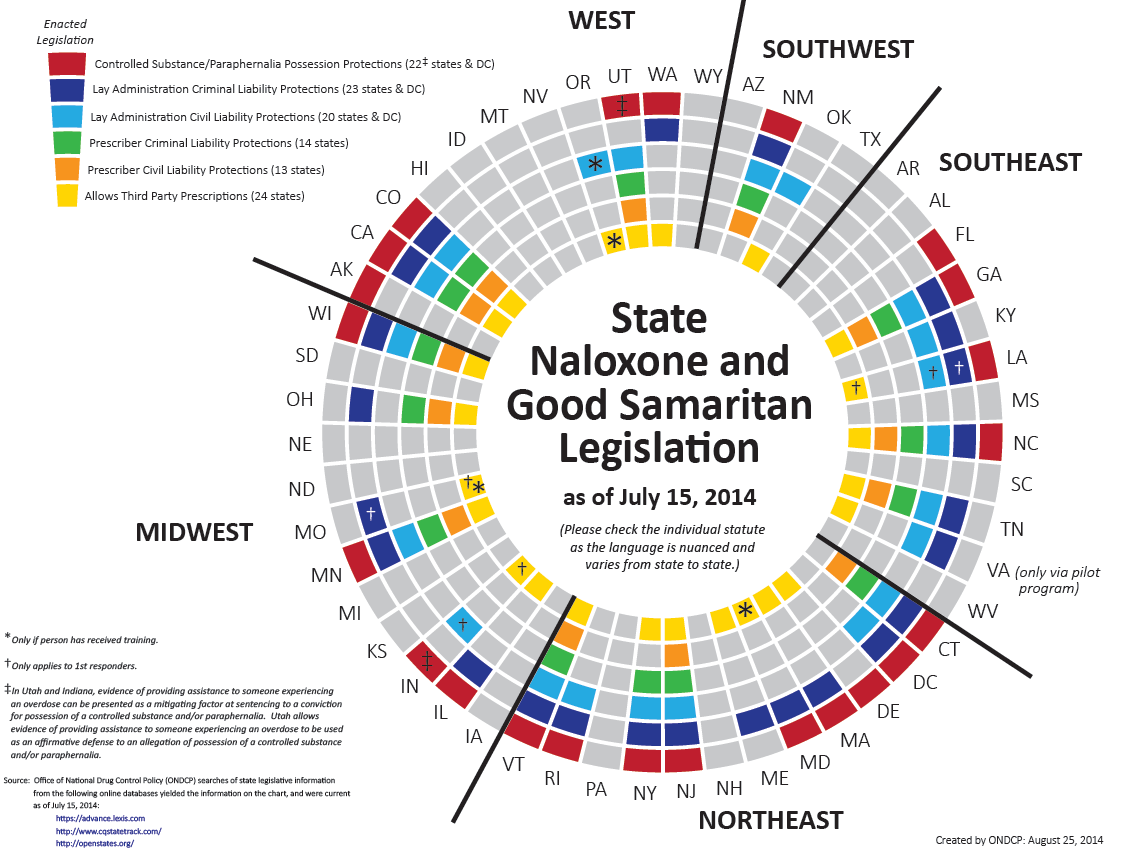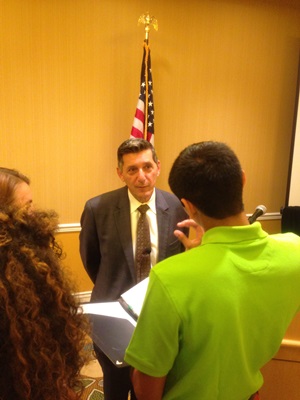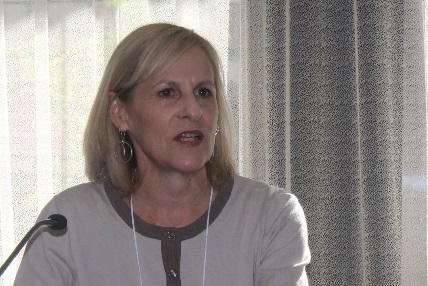ONDCP Blog
Announcing New Rules for Prescription Drug Disposal
Posted by on September 8, 2014 at 5:53 PM ESTToday, we joined the Drug Enforcement Administration (DEA) to announce new regulations that create convenient, legal avenues for safe, environmentally-friendly disposal of unneeded prescription drugs. Now, thanks to these regulations, neighborhood pharmacies and others will be able to set up disposal locations as well as administer mail-back programs. In August, President Obama also announced his newest Executive Action, which contains language providing that the United States Department of Defense (DOD) will direct its police force to carry naloxone, the life-saving overdose reversal drug.
These two actions mark a huge step forward in the Obama Administration’s work to curb the opioid epidemic, which claims more lives each year in America than motor vehicle crashes.
We know that about 70% of people who misuse prescription drugs get them for free from friends and family. Because of this, one of the four pillars of the Obama Administration’s Prescription Drug Abuse Prevention Plan is the safe storage and disposal of unused controlled substances. The regulations we’re announcing today will enable patients and families as well as long term care facilities to more easily dispose of unused prescription drugs properly, keeping both people and the environment safe from harm.
Today’s announcement is cause for celebration and renewed hope as we keep working to make communities safer and to prevent future overdose deaths. Read the new regulations on the Federal Register website and learn more about today’s announcement.
Learn more about2013 National Report on Drug Use and Health
Posted by on September 5, 2014 at 2:23 PM ESTYesterday, the Substance Abuse and Mental Health Services Administration (SAMHSA) released an overview of the findings of the 2013 National Survey on Drug Use and Health (NSDUH). The short report released yesterday showed that in 2013 illicit drug use in America was stable over the previous year:
- Among young adults (18 to 25) there was no change in either past month use of any illicit or marijuana; this pattern is unchanged since 2008. However, there was a decline in past month use of pain relievers from 2012; from 3.8% to 3.3%.
- Among older adults (26+), while there was no change in past month use of any illicit or marijuana from 2012, both are up significantly from 2011 (6.3% to 7.3% and 4.8% to 5.6%, respectively).
- In 2013, 1.4 percent of adolescents had a co-occurring major depressive episode and substance use disorder (SUD); 3.2 percent of adults had co-occurring "any mental illness" and SUD; and 1.0 percent of adults had a co-occurring serious mental illness and SUD.
- In 2013, 24.6 million people aged 12 or older (9.4%) were current illicit drug users, including 2.2 million adolescents aged 12 to 17. While current marijuana use among this population was unchanged from 2012, it has been increasing in recent years, rising from 5.8 percent in 2007 to 7.5 percent in 2013.
- Past month use of any illicit drug among adolescents declined significantly from 2012 to 2013 (9.5% to 8.8%); this appears to be driven by declines in prescription drug use: pain relievers from 2.2% to 1.7% and tranquilizers from 0.6% to 0.4%. While marijuana use among adolescents was unchanged from 2012, it is down significantly from 2011 (7.9% vs. 7.1%)—in the opposite direction of the trend for the population overall.
- 60.1 million people aged 12 or older were past month binge drinkers, including 1.6 million adolescents (ages 12 -17).
- Of the estimated 22.7 million people aged 12 or older in 2013 who needed treatment for an illicit drug or alcohol use problem, 2.5 million persons received treatment at a specialty facility.
Over the past three decades, the rate of drug use in America has declined by approximately 30%.

Download the short report here. The full survey results will be released later this month by SAMHSA.
Learn more aboutJoin Us on September 17 for Recovery Month at the White House
Posted by on September 5, 2014 at 10:30 AM ESTIn honor of the 25th Anniversary of National Alcohol and Drug Addiction Recovery Month, the Office of National Drug Control Policy (ONDCP) will host a celebratory event at the White House called “Recovery Month at the White House: Celebrating 25 Years.” The event, which will be streamed live on September 17, will feature a panel of recovery advocates who will share their inspirational personal stories and participate in a discussion. Viewers will be able to tweet questions for the panelists at @Botticelli44 using the hashtag #RecoveryatWH at any time prior to or during the event.
The panel discussion will be moderated by Laurie Dhue, a television journalist and recovery advocate. She will be joined on the panel by:
- Christina Huffington, a young person in recovery;
- Cris Carter, a former NFL football player and current ESPN analyst in recovery;
- Ruben Castaneda, a veteran Washington Post reporter who recently wrote about his path to recovery in his book, S Street Rising;
- Tim Willson, the mayor of Brooklyn Center, Minnesota.
The Recovery Month at the White House event will help raise awareness of substance use disorders and recovery, highlight Administration priorities and accomplishments in this area, educate the public and policymakers, and help dispel stigma by promoting the understanding that addiction is a disease and not the result of a personal or family failing. The webcast will also serve to inspire and mobilize the millions of Americans in recovery while holding out hope to millions of people across the country currently struggling with addiction to alcohol or other drugs.
We urge you to take the opportunity to watch, participate via Twitter, and post to other social media sites about the event. And if you’re planning to host a viewing party, we’d love to hear about it. Register your viewing party here.
Please share with your friends, loved ones, and colleagues that “Recovery Month at the White House: Celebrating 25 Years” will be webcast live from 2-4 p.m. EST, September 17. Tune in and spread the word!
We hope you will join us for this special event. Until then, check our Americans in Recovery Facebook page, @ONDCP and Acting Director Botticelli’s Twitter account for updates.
Learn more aboutInfographic: Overdose Prevention, State by State
Posted by on August 29, 2014 at 11:34 AM ESTSunday, August 31st is Overdose Awareness Day. In recognition of this day we would like to turn our attention to the faces behind the overdose statistics.
You have no doubt heard that in 2011 more Americans died every day from drug overdoses than from traffic crashes. And that half of those overdoses involved opioids, a class of drugs that includes heroin and prescription painkillers.
We would like to take a moment to talk about the people behind these data.
We greatly appreciate the willingness of parents to share their stories of loss with us. It goes without saying that family and friends who have lost a loved one due to overdose are heartbroken. And they are desperate to make sure no one else experiences what they have.
We heard from Liz’s mom. Liz was just 23 years old when her life was cut short due to an overdose. Her mom told us proudly that Liz graduated 10th in her high school class. She had a scholarship to college. And she was addicted to heroin.
We also heard from Joe’s mom. Joe was 29 when he died. She sent us a poem he wrote. The poem included the line, “No one told me getting high was such a low ride.”
And Judy told us about the loss of her son Steve. Steve said of prescription painkillers, “At first they were a lifeline. Now they are a noose around my neck.”
These people are more than statistics. They are our sons, daughters, neighbors, family and friends. They are the reason we work every day to decrease prescription drug abuse, heroin use and overdose deaths.
We are not without hope – and powerful tools to decrease overdose deaths. While prevention and treatment remain key parts of our overall drug strategy, we are also working to expand the availability of naloxone. Naloxone, when administered quickly and properly, is a medication that can reverse the effects of an opioid overdose that might otherwise result in death.
An increasing number of states are passing legislation to increase access to naloxone and remove barriers that may keep a bystander (or “Good Samaritans”) from seeking emergency assistance for the overdose victim. The infographic below shows states (and the District of Columbia) with laws allowing for the prescribing and administration of naloxone and/or criminal protections for bystanders who seek emergency assistance.
As of July 15, 2014, 30 states and the District of Columbia enacted legislation to decrease overdose deaths. The infographic provides an at-a-glance view of which states have passed and enacted these laws as of July 15:

If you found this graphic useful, please share it. We encourage you to learn more by downloading an overdose prevention toolkit developed by one of our federal partners.
Below is a summary of salient points in the infographic, with the corresponding colors.
Red: Twenty states (AK, CA, CO, CT, DE, FL, GA, IL, LA, MD, MA, MN, NJ, NM, NY, NC, RI, VT, WA, & WI) and the District of Columbia have statutes which prevent charge or prosecution for possession of a controlled substance and/or paraphernalia for persons who seek medical/emergency assistance for someone experiencing an opioid-induced overdose. Additionally, in UT and IN, evidence of providing assistance to someone experiencing an opioid overdose can be presented as a mitigating factor at sentencing to a conviction for possession of a controlled substance and/or paraphernalia. Utah allows evidence of providing assistance to someone experiencing an overdose to be used as an affirmative defense to an allegation of possession of a controlled substance and/or paraphernalia.
Purple: Twenty-one states (CA, CO, CT, GA, IL, KY, ME, MD, MA, MN, NJ, NM, NY, NC, OH, RI, TN, VT, VA, WA, & WI) and the District of Columbia have statutes which protect lay persons from criminal liability for administering naloxone to someone believed to be experiencing an opioid induced overdose. In Virginia, this protection applies to persons who are participating in the provisional pilot program. Two additional states (LA & MO) provide criminal liability protections to first responders.
Blue: Eighteen states (CA, CO, CT, GA, KY, MN, NJ, NM, NY, NC, OK, OR, RI, TN, UT, VT, VA, & WI) and the District of Columbia have statutes which protect lay persons from civil liability for administering naloxone to someone believed to be experiencing an opioid induced overdose. In Virginia, this protection applies only to persons participating in the provisional pilot program. Two additional states (IN & LA) provide civil liability protections to first responders.
Green: Fourteen states (CA, CO, CT, GA, MN, NJ, NM, NY, NC, OH, TN, UT, VT, & WI) have statutes which protect prescribers from criminal liability actions.
Orange: Thirteen states (CA, CO, CT, GA, MN, NJ, NM, NC, OH, TN, UT, VT, & WI) have statutes which protect prescribers from civil liability actions.
Yellow: Twenty-one states (CA, CO, DE, GA, IL, ME, MD, MA, MN, NJ, NY, NC, OH, OK, OR, TN, UT, VT, VA, WA, & WI) have statutes which allow for “third-party” prescriptions of naloxone (i.e., the prescription can be written to a friend, relative, or person in a position to assist a person at risk of experiencing an opioid overdose). Virginia allows third-party prescriptions only through a provisional pilot program. Three more states (IN, LA, & MO) allow prescriptions of naloxone to qualified first responders (e.g., law enforcement, EMTs, and firefighters).
Learn more aboutSecuring the Border: A Strategy to Reduce Drug Trafficking Between the United States and Canada
Posted by on August 19, 2014 at 9:30 AM ESTToday I traveled to the Bakken oil field region to announce the release of the 2014 National Northern Border Counternarcotics Strategy (Strategy), which updates and expands upon the Obama Administration’s first Strategy released in 2012. Like the inaugural Strategy, this document sets forth the Administration’s plan to reduce the illegal trafficking of drugs across the U.S.-Canada border.
There are inherent challenges in curtailing illicit drug trafficking across the Northern border. Among them are the vastness of the border itself, which extends more than 5 thousand miles, as well as the ever-evolving illegal drug production and trafficking trends that confront law enforcement officers. In fact, my visit earlier today was prompted by one such trend: the emergence of drug trafficking and related crime resulting from the development of the Bakken oil fields of northeastern Montana, northwestern North Dakota, and southern Saskatchewan. In recognition of this emerging threat, the 2014 Strategy includes a section dedicated to drug trafficking in the Bakken region and our efforts to address this threat.
Despite the challenges that we face, we are confident that by building upon our strong history and shared commitment with our Canadian partners, we will succeed in reducing cross-border illegal drug trafficking. Through integrated cross-border law enforcement efforts, the United States and Canada will build upon existing relationships, programs, and policies; will seek further opportunities to pursue national security by disrupting transnational criminal organizations; and will improve information sharing, enabling more efficient and effective use of resources to curb the flow of illicit drugs and drug proceeds across the Northern border.
The Strategy provides an overview of current counternarcotics efforts and identifies strategic objectives and specific actions that support the strategic goal to substantially reduce the flow of illicit drugs and drug proceeds along the Northern border. In updating and expanding upon the Administration’s first Strategy, the 2014 Strategy incorporates some significant changes and additions, such as the inclusion of sections addressing drug trafficking in the Bakken oil field region and the emerging threat posed by synthetic drugs; enhancements to the financial investigations section, including the addition of three new action items focusing on partnering with the private sector, targeting virtual currency and electronic payment devices, and targeting trade-based money laundering schemes; the addition of two new action items focused on eliminating public corruption; and significant enhancements to the section detailing our cooperative efforts with our Canadian counterparts.
Michael Botticelli is the Acting Director of National Drug Control Policy.
Learn more aboutONDCP’s Acting Director Plays ‘Mayor Botticelli’ in Mock City Council Meeting
Posted by on August 6, 2014 at 4:15 PM ESTA big surprise awaited the more than 40 teens attending the Community Anti-Drug Coalitions of America’s (CADCA’s) Mid-Year Training Institute in Orlando, Florida, on July 23. As they prepared for a training session – a Mock City Council Meeting – they were unaware that the “mayor” presiding over the meeting would be none other than Michael Botticelli, ONDCP’s Acting Director.
Their participation in the event, part of CADCA’s National Youth Leadership Initiative, gave the teens an opportunity to better understand the inner workings of local policymaking. It also helped them learn first-hand the value of speaking out and having their voices heard on important issues. In this instance, the topic for Council consideration was an ordinance to ban the sale of medical marijuana within the local jurisdiction.

Participating youth represented organizations on both sides of the issue, including the local school system, health care organizations, and the cannabis industry association. Their peers served as City Council representatives and reporters from a local TV station who were summoned to cover the heated debate.

Throughout it all, “Mayor” Botticelli presided with a firm gavel and challenged the youth to support their points of view. In the end, the Council agreed to support the medical marijuana ban, offering many of the facts and figures they learned at CADCA’s Institute. The teens were thrilled by Acting Director Botticelli’s commitment and participation. As for the Acting Director, interacting with the youth was a highlight of his trip to Orlando. “I was impressed by the knowledge, skill, and passion these young people brought to the event,” he said. “It’s clear to me why they are so valuable in the effort to prevent substance use in their communities.”
Helen Hernandez is grants administrator for the Drug-Free Communities program.
Learn more aboutActing Director Botticelli Addresses Coalition Leaders at CADCA’s Mid-Year Training Institute
Posted by on August 1, 2014 at 9:50 AM ESTOn July 23, ONDCP Acting Director Michael Botticelli met with hundreds of young people and coalition leaders from around the country at the Community Anti-Drug Coalitions of America’s (CADCA’s) Mid-Year Training Institute in Orlando, Florida. Attendees included young people taking part in a CADCA youth leadership initiative and grantees in ONDCP’s Drug-Free Communities (DFC) Support Program.
It was a busy day for the Acting Director, featuring speeches, roundtable discussions, and even a chance to show off his acting skills.
Speaking at a DFC Town Hall meeting, Acting Director Botticelli shared details of the Administration’s recently released 2014 National Drug Control Strategy. At one point he was joined at the lectern by DFC Administrator Helen Hernandez. Together, they applauded the work of the anti-drug coalitions, whose leaders voiced their appreciation for the Strategy and, particularly, its emphasis on preventing drug use before it begins.

Acting Director Botticelli drew even greater applause with his announcement that ONDCP will increase funding for CADCA’s National Youth Leadership Initiative (NYLI), which equips young leaders with the knowledge and tools they need to get involved and bring about positive change in their communities. Specifically, ONDCP will provide additional funds to support the development of youth leaders representing special populations, such as LGBT youth, African-American and Hispanic youth, and youth from military families.
Earlier in the day, the Acting Director took part in several roundtable discussions with DFC coalitions, exploring such themes as how to address the issue of marijuana legalization and the importance of forging partnerships with ONDCP’s High Intensity Drug Trafficking Areas program.

In what was certainly the liveliest event of the day, the Acting Director got to play the part of “Mayor Botticelli” in a mock Town Council meeting. His task, which he eagerly accepted, was to preside over a make-believe council of young people as it heard opposing arguments and then voted on a proposal to ban the use and sale of “medical” marijuana.
Throughout the day, Acting Director Botticelli met and spoke with local coalition leaders, who shared stories of their success in implementing local solutions to local issues. Grantees were impressed by the time and energy he put into the event and thrilled by the Administration’s show of support for the DFC program and anti-drug coalitions nationwide.
Helen Hernandez is grants administrator for the Drug-Free Communities program.
Learn more aboutRecognizing Leadership to Combat Viral Hepatitis
Posted by on July 29, 2014 at 3:56 PM ESTIn the United States, millions of Americans are infected with viral hepatitis, a life-threatening disease, with more than two-thirds unaware of their infection.
Though this disease can affect anyone, viral hepatitis impacts certain communities more than others. African Americans, American Indians, Asian American and Pacific Islanders, the baby boomer generation (those born between 1945 and 1965), and people living with HIV are all disproportionately affected by viral hepatitis. Rates are also higher among people who inject drugs.
All forms of viral hepatitis pose serious health threats, but building public awareness can help prevent new cases and more effectively treat this epidemic and related health issues such as HIV and substance use disorders. Thanks to the tireless leadership of researchers and advocates, we are beginning to break the silence surrounding viral hepatitis.
In commemoration of World Hepatitis Day, held annually on July 28, the Office of National Drug Control Policy and Office of National AIDS Policy are honoring national and international efforts to address the “silent epidemic” and achieve the goals of the Action Plan for the Prevention, Care, and Treatment of Viral Hepatitis.
In recognition of Leadership in Prevention and Treatment of Viral Hepatitis,
and
Advancing the Goals of the
Action Plan for the Prevention, Care, and Treatment of Viral Hepatitis
American Association for the Study of Liver Diseases

Barbara Murray, MD
Infectious Disease Society of America

Samuel So, MD
Asian Liver Center, Stanford University School of Medicine

Daniel Raymond
Harm Reduction Coalition

Joan Block, RN, BSN
Hepatitis B Foundation

Michael Ninburg, MPA
Hepatitis Education Project

Julie Scofield
National Alliance of State & Territorial AIDS Directors

Jules Levin, MS
National AIDS Treatment Advocacy Project

Charles Howell, MD
National Medical Association

Holly Hagan PhD, MPH, RN
New York University College of Nursing

Sanjeev Arora, MD
Project ECHO, University of New Mexico

Daniel O’Connell, MA, MLS
New York State Department of Health, AIDS Institute
 Charles Gore
Charles GoreWorld Hepatitis Alliance
Please join us virtually on Wednesday, July 30, from 12:00 PM to 2:30 PM EST, on www.whitehouse.gov/live as we recognize these leaders and provide a forum for domestic and international stakeholders to strengthen their responses to viral hepatitis and associated issues such as HIV and substance use disorders. The program will feature remarks from senior Federal officials, representatives from international and national organizations, and community leaders, including:
- Michael Botticelli, Acting Director, National Drug Control Policy
- Douglas Brooks, Director, White House Office of National AIDS Policy
- Representative Mike Honda (CA-17), Co-Chair, Congressional Hepatitis Caucus
- Ambassador Deborah Birx, U.S. Global AIDS Coordinator
- Dr. Howard Koh, Assistant Secretary for Health
- Dr. Paul Farmer, Partners in Health
Learn more aboutResponse to The New York Times Editorial Board's Call for Federal Marijuana Legalization
Posted by on July 28, 2014 at 5:40 PM ESTThe New York Times editorial board opined in its Sunday July 27, 2014 edition that the Federal government should legalize marijuana for adults aged 21 years and older. The New York Times editorial board compares Federal marijuana policy to the failure of alcohol prohibition and advocates for legalization based on the harm inflicted on young African American men who become involved in the criminal justice system as a result of marijuana possession charges. We agree that the criminal justice system is in need of reform and that disproportionality exists throughout the system. However, marijuana legalization is not the silver bullet solution to the issue.
In its argument, The New York Times editorial team failed to mention a cascade of public health problems associated with the increased availability of marijuana. While law enforcement will always play an important role in combating violent crime associated with the drug trade, the Obama Administration approaches substance use as a public health issue, not merely a criminal justice problem.
The editorial ignores the science and fails to address public health problems associated with increased marijuana use. Here are the facts:
- Marijuana use affects the developing brain. A recent study in Brain reveals impairment of the development of structures in some regions of the brain following prolonged marijuana use that began in adolescence or young adulthood.[1] Marijuana use is associated with cognitive impairment, including lower IQ among adult chronic users who began using marijuana at an early age.[2]
- Substance use in school age children has a detrimental effect on their academic achievement. Students who received earned D’s or F’s were more likely to be current users of marijuana than those who earned A’s (45% vs. 10%).[3]
- Marijuana is addictive. Estimates from research suggest that about 9 percent of users become addicted to marijuana. This number increases to about 17 percent among those who start young and to 25-50 percent among people who use marijuana daily.[4]
- Drugged driving is a threat to our roadways. Marijuana significantly impairs coordination and reaction time and is the illicit drug most frequently found to be involved in automobile accidents, including fatal ones.[5]
The editors of The New York Times may have valid concerns about disproportionality throughout our criminal justice system. But we as policy makers cannot ignore the basic scientific fact that marijuana is addictive and marijuana use has harmful consequences. Increased consumption leads to higher public health and financial costs for society. Addictive substances like alcohol and tobacco, which are legal and taxed, already result in much higher social costs than the revenue they generate. The cost to society of alcohol alone is estimated to be more than 15 times the revenue gained by its taxation.[6] For this reason, the Obama Administration and the Office of National Drug Control Policy remain committed to drug use prevention, treatment, support for recovery, and innovative criminal justice strategies to break the cycle of drug use and associated crime. This approach is helping improve public health and safety in communities across the United States.
Two recent studies by the nonpartisan RAND Institute suggest that policies making drugs more available would likely not eliminate illicit sales or increase tax revenues to the extent that marijuana legalization advocates predict. The first study examined various methods of measuring marijuana use and found that people under 21 account for a substantial share of marijuana consumption. Under most legalization schemes those under 21 would not be able to purchase marijuana legally; therefore, they would continue to turn to the grey market of illicit or diverted legal marijuana to obtain the drug. The second study examined the likely impact of California’s 2012 initiative to legalize marijuana use and concluded that dramatically lowered prices for marijuana as a result of legalization could mean substantially lower potential tax revenue for the state.
We are also keeping a close eye on the states of Washington and Colorado in conformance with the directive provided by the Attorney General in August 2013.
Any discussion on the issue should be guided by science and evidence, not ideology and wishful thinking. The Obama Administration continues to oppose legalization of marijuana and other illegal drugs because it flies in the face of a public health approach to reducing drug use and its consequences. Our approach is founded on the understanding of addiction as a disease that can be successfully prevented and treated, and from which people can recover. We will continue to focus on genuine drug policy reform – a strategy that rejects extremes, and promotes expanded access to treatment, evidence-based prevention efforts, and alternatives to incarceration.
Note: This post was updated with a correction from Beau Kilmer, an author of the two RAND Corporation studies mentioned above.
[1] Zalesky A, et al. 2012. Effect of long-term cannabis use on axonal fibre connectivity. Brain: A Journal of Neurology. 135 (7): 2245-2255. Available at http://brain.oxfordjournals.org/content/135/7/2245.full.pdf+html
[2] Meier et al., “Adolescent-onset cannabis and neuropsychological health.” Proceedings of the National Academy of Sciences.
[August 27, 2012]. Available: http://www.pnas.org/content/early/2012/08/22/1206820109
[3] Centers for Disease Control and Prevention, Department of Health and Human Services. Alcohol and Other Drug Use and Academic Achievement. 2010. Available at http://www.cdc.gov/healthyyouth/health_and_academics/pdf/alcohol_other_d...
[4] Anthony, JC; Warner, LA, Kessler, RC. 1994. Comparative epidemiology of dependence on tobacco, alcohol, controlled substances, and inhalants: Basic findings from the National Comorbidity Survey. Experimental and Clinical Psychopharmacology 2:244-268.
[5] Brady JE, Li G (2014) Trends in Alcohol and Other Drugs Detected in Fatally Injured Drivers in the United States, 199-2010,” American Journal of Epidemiology [Epub ahead of print].
[6] Ellen E. Bouchery, Henrick J. Harwood, Jeffrey J. Sacks, Carol J. Simon, Robert D. Brewer. Economic Costs of
Excessive Alcohol Consumption in the U.S., 2006. American Journal of Preventive Medicine - November 2011
(Vol. 41, Issue 5, Pages 516-524, DOI: 10.1016/j.amepre.2011.06.045). Available:
http://www.ajpmonline.org/article/S0749-3797(11)00538-1/fulltext xiii Kilmer, Beau, et al., Reducing Drug Trafficking Revenues and Viol
[7] Kilmer, Beau, et al., Reducing Drug Trafficking Revenues and Violence in Mexico: Would Legalizing Marijuana
in California Help? RAND Corporation. [2010]. Available:
http://www.rand.org/content/dam/rand/pubs/occasional_papers/2010/RAND_OP...
[8] Kilmer, Beau, et al., Altered States? Assessing How Marijuana Legalization in California Could Influence
Marijuana Consumption and Public Budgets. RAND Corporation. [2010]. Available:
http://www.rand.org/content/dam/rand/pubs/occasional_papers/2010/RAND_OP...
Learn more aboutWomen’s Addiction Forum
Posted by on July 28, 2014 at 12:37 PM ESTLast week, I was honored to attend a bipartisan forum on women and addiction on Capitol Hill, hosted by Senators Sheldon Whitehouse (D-RI), Amy Klobuchar (D-MN), Rob Portman (R-OH), and Kelly Ayotte (R-NH). The forum focused on the unique challenges women face while suffering from substance use disorders. In my remarks, I mentioned an alarming statistic regarding drug use and pregnancy in young women.
Almost one in five (18.3 percent) pregnant teens aged 15 to 17 reported using an illicit drug in the past month, compared to fewer than 1 in 20 (3.4 percent) pregnant women aged 26 to 44.[i] These statistics are even more alarming in light of data from the Centers for Disease Control and Prevention indicating that the percentage of women succumbing to fatal overdoses involving opioids has risen much more sharply than that for men. From 1999 to 2011, the increase in deaths in women has risen over 400 percent, as compared to 265 percent in men.[ii] These statistics are deplorable, and for this reason, as outlined in our 2014 National Drug Control Strategy, the Obama Administration seeks to decrease drug-induced deaths by 15 percent this year through promoting strong nationwide policies that help improve access to evidence-based treatment, including medication-assisted treatment for opioid use disorders and much more.
This week’s forum also included discussions by other individuals who brought years of experience and education on this topic to the table. Subjects of discussion included lectures on the type of treatment most effective for women, substance use disorders and motherhood, and the role of trauma as a factor contributing to substance use disorders, relapse, and recidivism in women.
I hope to see more of these bi-partisan discussions aimed at reducing – and ultimately eliminating – the stigma associated with those suffering from or in recovery from substance use disorders. Even for people in dire need of substance use disorder treatment, stigma can be an insurmountable barrier to getting help. As a person in recovery myself, I am determined to help people get the treatment they need to live happy, healthy, and productive lives in recovery. The Obama Administration remains committed to reducing drug use and its consequences.
[i] SAMHSA. National Survey on Drug Use and Health, 2011 and 2012. Unpublished special tabulations (September 2013).
[ii] Centers for Disease Control and Prevention, National Center for Health Statistics. Multiple Cause of Death 1999-2011 on CDC WONDER Online Database, released 2014. Accessed at http://wonder.cdc.gov/mcd-icd10.html on Jul 25, 2014.
Learn more about
- &lsaquo previous
- 1
- 2
- 3
- 4
- 5
- 6
- 7
- 8
- 9
- …
- next &rsaquo
